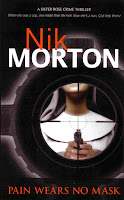That
has now been dropped. The situation pertaining to that is of some interest,
regardless of the outcome.
Many
new writers worry about copyright infringement, fearing that unscrupulous
literary agents and editors will steal their book and republish it under their
name. Plagiarism does exist, though it is rare and not worth losing sleep over.
As soon as you commit your words to paper, those words are your copyright. They
are protected by law. However, should your words be stolen, then you have to
prove the theft and could spend considerable sums of money in the attempt. The
greater concern is the concept of ideas. Sadly, ideas are not copyright. Over
the decades I’ve seen some of my ideas appear elsewhere after I’d committed
them to paper, but I must be philosophical about this.
It
could be something to do with Jung’s collective unconscious, or even the
so-called collective consciousness. In essence, ideas (and this includes inventions)
often seem to percolate through the ether and lodge in several minds at once –
or they’re submerged very much like being entombed in an iceberg and gradually
surface as the ice melts, spreading to receptive centres. Coincident with this
is the idea of synchronicity. As an aside, Jung suggested that parapsychology and occult religious ideas could
contribute understanding of the collective unconscious.
These ideas have a certain attraction – particularly when linked to my psychic
spy Tana Standish (The Prague Papers
and The Tehran Text). Based on Jung’s
interpretation of synchronicity and extra-sensory perception, he argued that
psychic activity transcended the brain. This is all moot.
In
the early 1970s I conceived and roughly plotted a sci-fi book set underground
after some apocalypse (doubtless inspired by Daniel F Galouye’s Dark Universe). The characters
communicated by telepathy, they’d been there so long. At the time I was
interested in the plight of whales, too – having read Farley Mowat’s A Whale for the Killing (1972) among
other books and tracts. I thought of linking the underground people telepathically
to whales (it’s explained in the notes…) Some years later, along came that most
endearing movie, Star Trek IV: The Voyage
Home which neatly combined whales and sci-fi. The ideas I had then are
still in a file; they may resurface one day.
Also
in the mid-1970s I decided to write a vampire book. I’d found it difficult (!)
to square the mass of a human being converting into the mass of a single
vampire bat (which seemed to be the norm up to this point). It wasn’t
scientific – well, no, it was fantasy.
Anyway, I developed my vampire from the past of Malta and he would
transform into forty-six bats, each with his mind and sight, slightly
splintered. True, even that number of bats would not equate to the mass of a
man, but I felt it was marginally more believable! It began life as a short
story but had no success so then harboured dust until I got around to writing
the novel it was meant to be. In the meantime, along came Alan Moore and Kevin
O’Neill’s comic, The League of
Extraordinary Gentlemen (1999) [subsequently filmed in 2003] and the
vampire splits up into many bats… I finally found a publisher for my vampire
tale, Death is Another Life (2012); though
it picked up good reviews, it’s now out-of-print.
Imagine
my surprise when I found Alison Joseph’s Sacred
Hearts (1994) on a bookstore shelf – ‘a Sister Agnes mystery’.
Coincidentally, her agent was one of those I’d approached with my nun manuscript.
The only vague similarity was that Sister Agnes ran a hostel for runaway
teenagers. Her series ran to nine novels, the last being published in 2008. My
nun book won a prize in the Harry Bowling competition in 2006 and in 2007 it was
published as Pain Wears No Mask (now
set in Newcastle upon Tyne and London; it had featured Sister Hannah but now featured
Sister Rose; it picked up rave reviews!); it’s presently out of print.
The
moral of all this? Don’t get anxious about your work being stolen. It probably
won’t ever happen. I’m sure that, like me, most writers have more than enough
of their own ideas to work with to bother filching them from newcomers. But bear in mind, ideas are floating out there, and they could be part of a shared consciousness!
If you wish, you can try my in-print books here… (e-books/print)
PS - The Prague Papers is selling as a bargain e-book all this week!





























No comments:
Post a Comment